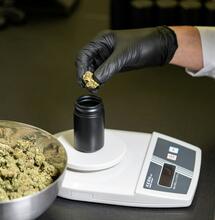Outdoor Growing

At Dutch Passion we get to speak with lots of successful outdoor growers. What follows is a collection of their best tips, which will give you a good chance of outdoor success in 2013. Just a few mature female Cannabis plants can be enough to provide a grower with a year's supply of recreational or medicinal stash. Even if you have never grown outdoors before, with a little bit of planning and a pack of decent seeds, you may be able to become self-sufficient in your Cannabis supply - and never need to buy weed again.
At Dutch Passion we get to speak with lots of successful outdoor growers. What follows is a collection of their best tips, which will give you a good chance of outdoor success in 2013. Just a few mature female Cannabis plants can be enough to provide a grower with a year's supply of recreational or medicinal stash. Even if you have never grown outdoors before, with a little bit of planning and a pack of decent seeds, you may be able to become self-sufficient in your Cannabis supply - and never need to buy weed again.
At Dutch Passion we get to speak with lots of successful outdoor growers. What follows is a collection of their best tips, which will give you a good chance of outdoor success in 2013. Just a few mature female Cannabis plants can be enough to provide a grower with a year's supply of recreational or medicinal stash. Even if you have never grown outdoors before, with a little bit of planning and a pack of decent seeds, you may be able to become self-sufficient in your Cannabis supply – and never need to buy weed again.
| If you can, grow the plants in your own yard (Strain: Frisian Dew) |
The dedicated outdoor grower often has several grow locations, so even if some plants are lost, there are still enough backup plants. The best plots are often used for many years and can be developed and improved by the grower. The earth can be dug over winter and spring, fertilizers can be added and the quality of the soil can be steadily improved. Weeds and undesired plants can be removed. Sometimes the grower will deliberately add extra plants nearby, such as brambles, to deter people and animals from getting too close. The hardest part of outdoor growing is finding and preparing the plot.
Online mapping programs such as Bing and Google Maps are a good way for outdoor growers to look for potential growing locations. The best places are south-facing plots with a minimal amount of shade. Especially for growers in northern Europe, where summers are already short, Cannabis plants need a sheltered and sunny spot where they have the best possible chance of success. Always look for spots that cannot be easily found by other people (farmers, dog-walkers, etc.) The determined grower will create his own private plot by crawling into the undergrowth, perhaps in the center of brambles, and hacking down a suitably sized area. Then comes the hard job of 'turning' or digging manure, fertilizers and nutrients into the soil. Always leave enough foliage around the outside of your plot to keep the center hidden.
| Remote locations are ideal for hiding your crop (Strain: Holland's Hope) |
| Ultimately, its best if you only visit the plants a few times (Strain: Holland's Hope) |
| Outdoor plants are often difficult to conceal due to size (Strain: Purple #1) |
If you don't yet have a pair of walking boots, then it is worth investing in some. Many outdoor growers find that guerrilla growing gives them a good excuse to spend more time outdoors. Get to know the local public footpaths in the areas that you are considering for growing; you will find these 'rights of way' online or on printed maps. Ideally you do not want to be growing on anyone else's land. You do not want to be questioned by farmers who have found you walking on their land with a backpack of Cannabis seedlings or freshly-harvested aromatic herbs.
Some people do grow in urban areas, but these spots are not as easy to find, use or keep hidden. If you are really lucky you will be able to grow safely in your own yard or garden, but even those growers who have such spaces often prefer not to cultivate Cannabis there.
Even when growing in the middle of a hidden bramble plot, it is important to protect the Cannabis plants with wire- or plastic mesh to stop rabbits or other animals from feeding on them. You can use tent pegs to keep a wire mesh tube in place around a plant. You will also need to guard against slugs and may want to use either slug pellets or slug-repelling copper wire around the base of your plants. If you are able to visit your plants periodically, it may be necessary to re-apply slug pellets around the base of the plants. Some growers protect plants against deer by surrounding the grow area with a perimeter fence of fishing line. This doesn't harm the deer but it often persuades them to graze elsewhere.
| Holland's Hope will thrive in most outdoor conditions |
| Don't leave evidence behind when tending your plants (Strain: Purple #1) |
Rather than planting seeds outdoors, you will have more success by planting out small seedlings that are a few weeks old. Many growers start their plants indoors and will try to 'harden' their plants to outdoor conditions by putting them outside for a few hours each day. When the weather is warm enough, it is time to transport your plants to your grow location and plant them. Usually the seedlings are placed in a protective box and put in a backpack. The grower can approach the spot, ensure it is safe, and enter it with the plants. The ground should already have been fully prepared before the planting. The trip to plant the seedlings is usually a fairly quick job; the preparatory work should already have been done.
| Frisian Dew is a popular outdoor strain, for obvious reasons |
The most nerve wracking time for outdoor growers is the final visit to harvest the crop and transport it back home for drying. The smart outdoor grower organizes this final visit well. The trip should be planned carefully for a time that will offer the most privacy. The plant is trimmed and the buds put into an airtight container, such as seal-able plastic kitchen containers. Any remaining plant waste at the plot is dug back into the soil, so no evidence remains. The wire mesh tubes used to protect the small seedlings should also be removed to keep the site clean for the following year. Any other items (plastic bags, shovels, etc.) should also be removed to make sure the site looks natural when you have left it.
| Large outdoor plants can provide you with a reliable stash |
If you have never before considered growing outdoors, perhaps you will want to give it a try in 2013. Once you have found a good plot and grown some great outdoor weed, you will find you have a new hobby that you will enjoy for many years. Good luck!
Photos courtesy of Dutch Passion



